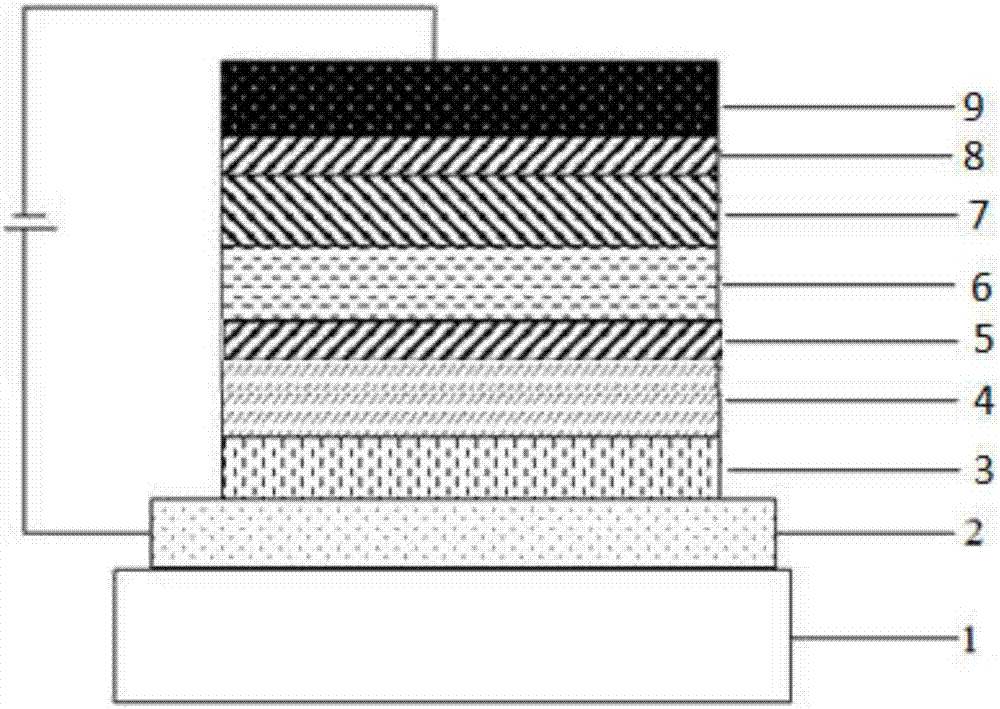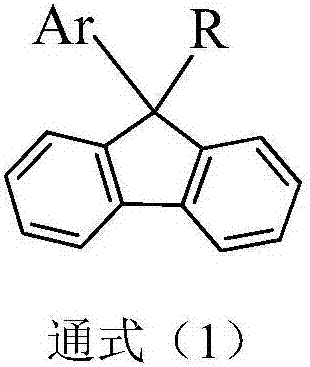Organic compound taking fluorene as core and application of organic compound
An organic compound, an organic technology, applied to the application of organic electroluminescent devices, in the field of organic compounds, can solve problems such as performance differences, achieve three-dimensional structure stability, improve material stability, and improve current efficiency and life.
- Summary
- Abstract
- Description
- Claims
- Application Information
AI Technical Summary
Problems solved by technology
Method used
Image
Examples
Embodiment 1
[0046] Embodiment 1: the synthesis of intermediate I and intermediate II
[0047] a. Synthesis of Intermediate I:
[0048]
[0049] (1) Weigh raw material U and Mg powder, dissolve with dry tetrahydrofuran (THF); under inert atmosphere, add catalyst amount I 2 , heated to 40°C and stirred until the solution changed from yellow to colorless, then heated the above mixed solution to 60-90°C, stirred and reacted for 3-5 hours, no magnesium powder remained, the reaction was complete, and Grignard reagent intermediate V was generated; The mol ratio of described raw material U and Mg is 1:1.0~1.2; I 2 The molar ratio with raw material U is 0.006~0.02:1;
[0050] (2) Weigh 9-fluorenone and dissolve it in dry THF; under an inert atmosphere, add the above-mentioned Grignard reagent intermediate V dropwise, and stir the resulting mixed solution at 60-90°C for 10-24 hours to generate a large amount of white Precipitate, then cool to room temperature, add saturated NHCl4 to convert G...
Embodiment 2
[0075] Embodiment 2: the synthesis of compound 5:
[0076]
[0077] In a 250mL three-neck flask, under a nitrogen atmosphere, add 0.01mol of intermediate M1, 0.015mol of intermediate O1, dissolve in a mixed solvent (90ml of toluene, 45ml of ethanol), and then add 0.03mol of Na 2 CO 3 aqueous solution (2M), stirred under nitrogen for 1 hour, then added 0.0001mol Pd(PPh 3 ) 4 , heating to reflux for 15 hours, sampling point plate, the reaction is complete. Naturally cooled, filtered, the filtrate was rotary evaporated, and passed through a silica gel column to obtain the target product with a purity of 99.5% and a yield of 76.4%. Elemental analysis structure (molecular formula C 46 h 32 O): Theoretical value C, 91.97; H, 5.37; O, 2.66; Test value: C, 91.96; H, 5.36; O, 2.68. ESI-MS(m / z)(M + ): The theoretical value is 600.25, and the measured value is 600.41.
Embodiment 3
[0078] Embodiment 3: the synthesis of compound 9:
[0079]
[0080] In a 250ml three-neck flask, under an atmosphere of nitrogen gas, add 0.01mol intermediate M1, 0.015mol intermediate O2, dissolve with a mixed solvent (90ml toluene, 45ml ethanol), and then add 0.03mol Na 2 CO 3 aqueous solution (2M), stirred under nitrogen for 1 hour, then added 0.0001mol Pd(PPh 3 ) 4 , heating to reflux for 15 hours, sampling point plate, the reaction is complete. Naturally cooled, filtered, the filtrate was rotary evaporated, and passed through a silica gel column to obtain the target product with a purity of 99.3% and a yield of 68.5%. Elemental analysis structure (molecular formula C 46 h 32S): theoretical value C, 89.57; H, 5.23; S, 5.20; test value: C, 89.55; H, 5.24; S, 5.21. ESI-MS(m / z)(M + ): The theoretical value is 616.22, and the measured value is 616.47.
PUM
| Property | Measurement | Unit |
|---|---|---|
| thickness | aaaaa | aaaaa |
| thickness | aaaaa | aaaaa |
Abstract
Description
Claims
Application Information
 Login to View More
Login to View More - R&D
- Intellectual Property
- Life Sciences
- Materials
- Tech Scout
- Unparalleled Data Quality
- Higher Quality Content
- 60% Fewer Hallucinations
Browse by: Latest US Patents, China's latest patents, Technical Efficacy Thesaurus, Application Domain, Technology Topic, Popular Technical Reports.
© 2025 PatSnap. All rights reserved.Legal|Privacy policy|Modern Slavery Act Transparency Statement|Sitemap|About US| Contact US: help@patsnap.com



